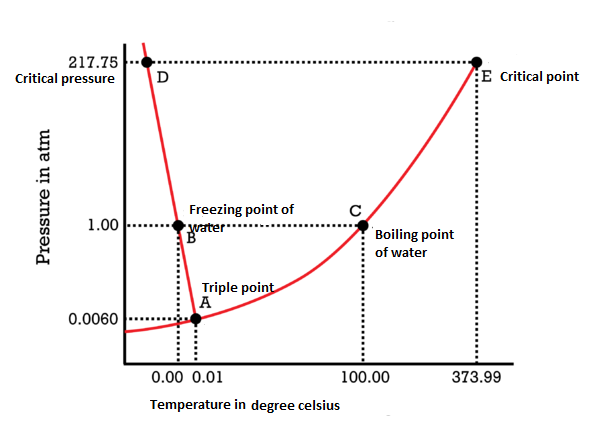
How do I make a phase diagram diagram for water?
Answer
457.8k+ views
Hint: Phase diagram is a graphical representation used for showing the physical states of a substance under different conditions of temperature and pressure. In a typical phase diagram pressure is present on the y-axis and the temperature is present on the x-axis.
Complete step by step answer:
Water is present in different forms, the water present in the solid form (ice) is less denser than the water present in the liquid form. As the liquid is changing to solid, the process here is the freezing. The freezing curve on the phase diagram represents the transition between liquid and solid states.
The phase diagram of the water is shown below.

The above diagram is edited using paint.
Triple point represents the point on a phase diagram at which the three states of matter: gas, liquid, and solid coexist
Critical point represents the point on a phase diagram at which the substance is indistinguishable between liquid and gaseous states.
In the phase diagram of water the slope between the solid and liquid states is negative rather than positive because water in solid state is less dense than the liquid state. This is why ice floats in liquid. Due to this, a pressure change has the opposite effect on those two phases. When the ice is relatively near its melting point, it can be changed into liquid water by applying pressure. The water molecules are actually closer together in the liquid phase than they are in the solid phase.
The point E, is the critical point which means that at
Note: Water has an exception as in the normal phase diagram the solid – liquid phase line slope is positive to the right, example in carbon dioxide but in case of water the slope between the solid and liquid states is negative.
Complete step by step answer:
Water is present in different forms, the water present in the solid form (ice) is less denser than the water present in the liquid form. As the liquid is changing to solid, the process here is the freezing. The freezing curve on the phase diagram represents the transition between liquid and solid states.
The phase diagram of the water is shown below.

The above diagram is edited using paint.
Triple point represents the point on a phase diagram at which the three states of matter: gas, liquid, and solid coexist
Critical point represents the point on a phase diagram at which the substance is indistinguishable between liquid and gaseous states.
In the phase diagram of water the slope between the solid and liquid states is negative rather than positive because water in solid state is less dense than the liquid state. This is why ice floats in liquid. Due to this, a pressure change has the opposite effect on those two phases. When the ice is relatively near its melting point, it can be changed into liquid water by applying pressure. The water molecules are actually closer together in the liquid phase than they are in the solid phase.
The point E, is the critical point which means that at
Note: Water has an exception as in the normal phase diagram the solid – liquid phase line slope is positive to the right, example in carbon dioxide but in case of water the slope between the solid and liquid states is negative.
Latest Vedantu courses for you
Grade 11 Science PCM | CBSE | SCHOOL | English
CBSE (2025-26)
School Full course for CBSE students
₹41,848 per year
Recently Updated Pages
Master Class 9 General Knowledge: Engaging Questions & Answers for Success

Master Class 9 English: Engaging Questions & Answers for Success

Master Class 9 Science: Engaging Questions & Answers for Success

Master Class 9 Social Science: Engaging Questions & Answers for Success

Master Class 9 Maths: Engaging Questions & Answers for Success

Class 9 Question and Answer - Your Ultimate Solutions Guide

Trending doubts
State and prove Bernoullis theorem class 11 physics CBSE

Who built the Grand Trunk Road AChandragupta Maurya class 11 social science CBSE

1 ton equals to A 100 kg B 1000 kg C 10 kg D 10000 class 11 physics CBSE

State the laws of reflection of light

One Metric ton is equal to kg A 10000 B 1000 C 100 class 11 physics CBSE

Difference Between Prokaryotic Cells and Eukaryotic Cells




